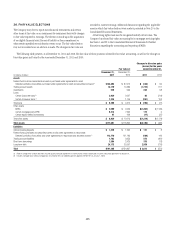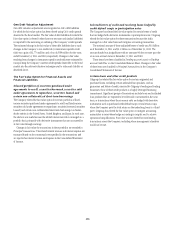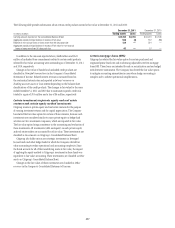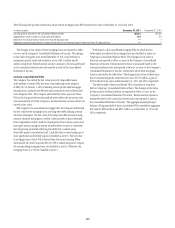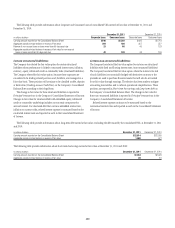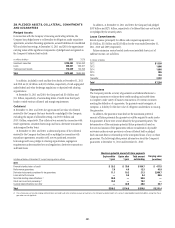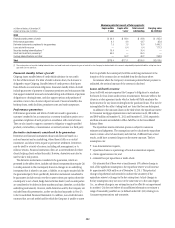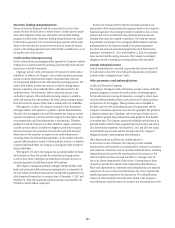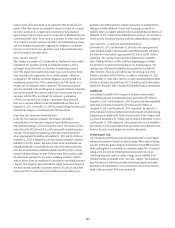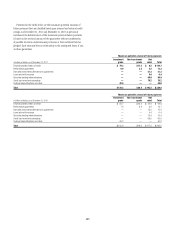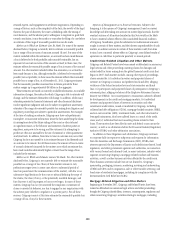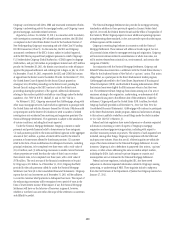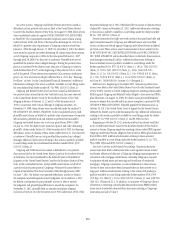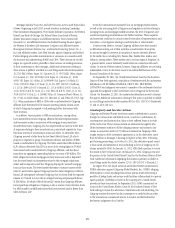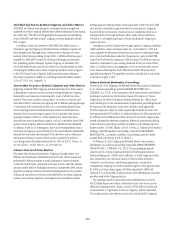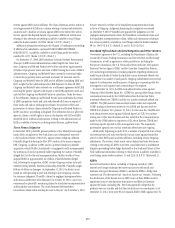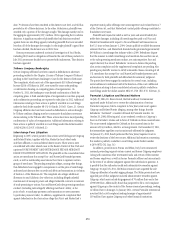Citibank 2011 Annual Report Download - page 286
Download and view the complete annual report
Please find page 286 of the 2011 Citibank annual report below. You can navigate through the pages in the report by either clicking on the pages listed below, or by using the keyword search tool below to find specific information within the annual report.264
normal course of business based on an assessment that the risk of loss is
remote. Often these clauses are intended to ensure that terms of a contract
are met at inception. No compensation is received for these standard
representations and warranties, and it is not possible to determine their fair
value because they rarely, if ever, result in a payment. In many cases, there
are no stated or notional amounts included in the indemnification clauses
and the contingencies potentially triggering the obligation to indemnify
have not occurred and are not expected to occur. These indemnifications
are not included in the tables above.
Value-Transfer Networks
The Company is a member of, or shareholder in, hundreds of value-transfer
networks (VTNs) (payment, clearing and settlement systems as well as
exchanges) around the world. As a condition of membership, many of
these VTNs require that members stand ready to pay a pro rata share of the
losses incurred by the organization due to another member’s default on
its obligations. The Company’s potential obligations may be limited to its
membership interests in the VTNs, contributions to the VTN’s funds, or, in
limited cases, the obligation may be unlimited. The maximum exposure
cannot be estimated as this would require an assessment of future claims that
have not yet occurred. We believe the risk of loss is remote given historical
experience with the VTNs. Accordingly, the Company’s participation
in VTNs is not reported in the Company’s guarantees tables above and
there are no amounts reflected on the Consolidated Balance Sheet as of
December 31, 2011 or December 31, 2010 for potential obligations that could
arise from the Company’s involvement with VTN associations.
Long-Term Care Insurance Indemnification
In the sale of an insurance subsidiary, the Company provided an
indemnification to an insurance company for policyholder claims and
other liabilities relating to a book of long-term care (LTC) business (for the
entire term of the LTC policies) that is fully reinsured by another insurance
company. The reinsurer has funded two trusts with securities whose fair
value (approximately $4.4 billion at December 31, 2011 and $3.6 billion at
December 31, 2010) is designed to cover the insurance company’s statutory
liabilities for the LTC policies. The assets in these trusts are evaluated and
adjusted periodically to ensure that the fair value of the assets continues to
cover the estimated statutory liabilities related to the LTC policies, as those
statutory liabilities change over time. If the reinsurer fails to perform under
the reinsurance agreement for any reason, including insolvency, and the
assets in the two trusts are insufficient or unavailable to the ceding insurance
company, then Citigroup must indemnify the ceding insurance company for
any losses actually incurred in connection with the LTC policies. Since both
events would have to occur before Citi would become responsible for any
payment to the ceding insurance company pursuant to its indemnification
obligation and the likelihood of such events occurring is currently not
probable, there is no liability reflected in the Consolidated Balance Sheet as of
December 31, 2011 related to this indemnification. However, Citi continues to
closely monitor its potential exposure under this indemnification obligation.
Carrying Value—Guarantees and Indemnifications
At December 31, 2011 and December 31, 2010, the total carrying amounts
of the liabilities related to the guarantees and indemnifications included in
the tables above amounted to approximately $3.2 billion and $2.1 billion,
respectively. The carrying value of derivative instruments is included in
either Trading liabilities or Other liabilities, depending upon whether
the derivative was entered into for trading or non-trading purposes. The
carrying value of financial and performance guarantees is included in
Other liabilities. For loans sold with recourse, the carrying value of the
liability is included in Other liabilities. In addition, at December 31, 2011
and December 31, 2010, Other liabilities on the Consolidated Balance Sheet
include an allowance for credit losses of $1,136 million and $1,066 million,
respectively, relating to letters of credit and unfunded lending commitments.
Collateral
Cash collateral available to the Company to reimburse losses realized
under these guarantees and indemnifications amounted to $35 billion at
December 31, 2011 and December 31, 2010. Securities and other marketable
assets held as collateral amounted to $65 billion and $41 billion at
December 31, 2011 and December 31, 2010, respectively, the majority of
which collateral is held to reimburse losses realized under securities lending
indemnifications. Additionally, letters of credit in favor of the Company held
as collateral amounted to $1.5 billion and $2.0 billion at December 31, 2011
and December 31, 2010, respectively. Other property may also be available to
the Company to cover losses under certain guarantees and indemnifications;
however, the value of such property has not been determined.
Performance risk
Citi evaluates the performance risk of its guarantees based on the assigned
referenced counterparty internal or external ratings. Where external ratings
are used, investment-grade ratings are considered to be Baa/BBB and above,
while anything below is considered non-investment grade. The Citi internal
ratings are in line with the related external rating system. On certain
underlying referenced credits or entities, ratings are not available. Such
referenced credits are included in the “not rated” category. The maximum
potential amount of the future payments related to guarantees and credit
derivatives sold is determined to be the notional amount of these contracts,
which is the par amount of the assets guaranteed.



